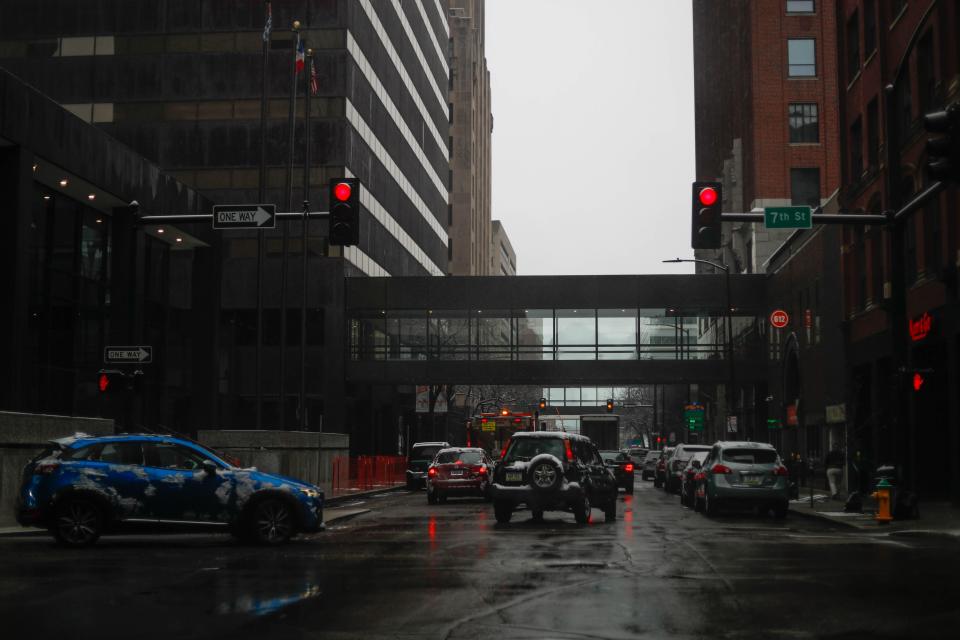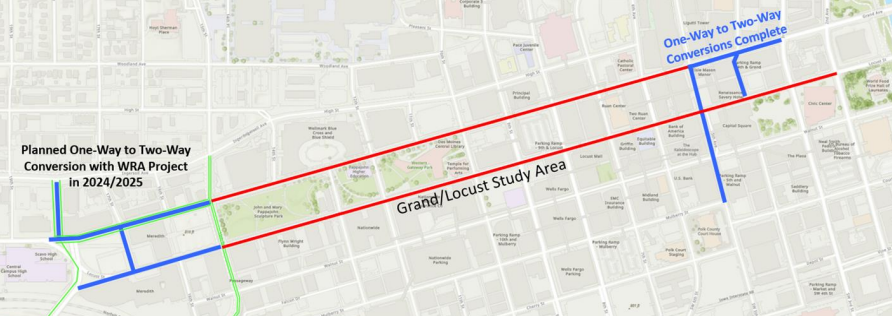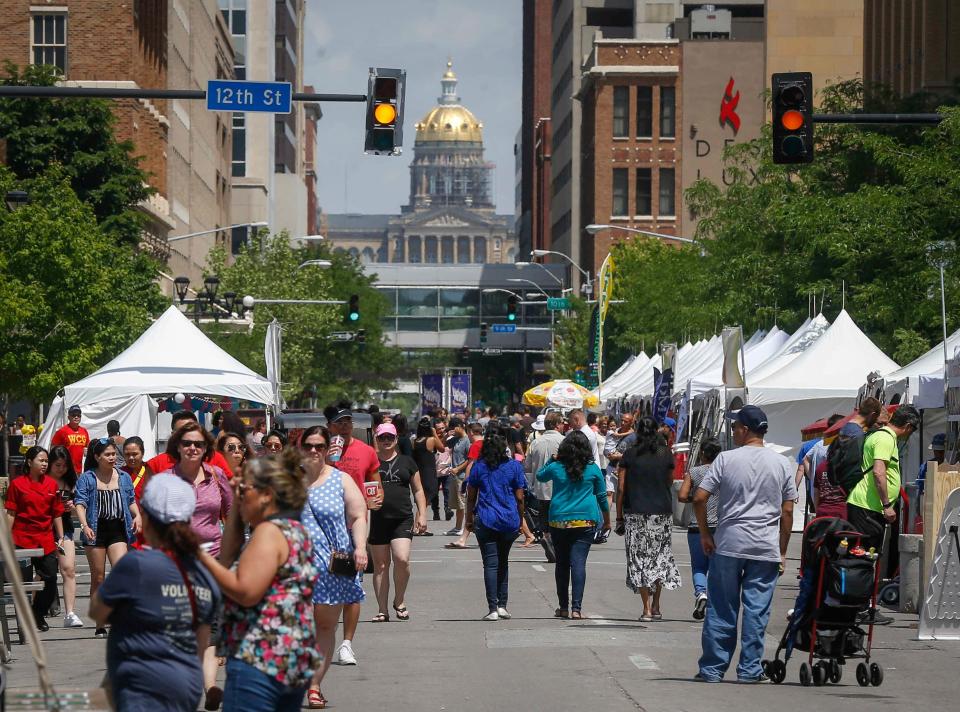Is a two-way conversion of Grand Avenue and Locust Street in downtown Des Moines possible?
A study to help determine whether two major Des Moines streets should be transformed into two-way corridors is nearly complete — and in the meantime, the city is asking residents to share their final thoughts on the potential project.
Last year, the city embarked on a traffic engineering study to determine the feasibility of turning Grand Avenue and Locust Street from Second Avenue to 15th Street from one-way to two-way roads.
The Des Moines City Council in November 2022 delayed the project after city staff voiced logistical concerns about the conversions on Grand Avenue and Locust Street, including impacts on emergency response and transit. It instead approved an agreement with consulting firm Felsburg Holt & Ullevig to research potential impacts.
City engineer Steve Naber said the study is nearly complete and expected to be published later this year. Ahead of its release, the city is slated to hold another public meeting to present options to update both streets, and collect feedback.
Here are some preliminary takeaways from the study and public input so far.

If they're not two-way, what are the options for Locust and Grand?
The study will show what the roads would look like if converted into two-way streets, according to Naber. It also will present potential alternatives, such as:
Making Grand a two-way street with buffered bike lanes and parking on one side, while Locust remains a one-way street with parking on both sides.
Making Grand a two-way street with two driving lanes and a middle turn lane, as well as adding a separate bike path and parking on one side. Locust also would be changed into a two-way street with turn lanes and parking on both sides.
Keeping Grand and Locust one-way streets, but narrowing Grand and adding a separate bike path, as well as having parking on both sides for Grand and Locust.
The study, which cost $327,405, examined street improvement opportunities for pedestrians and bicyclists, traffic signal timing, and impacts to on-street parking and loading zones. It included public feedback from stakeholders including residents, downtown employees, Des Moines Area Regional Transit Authority (DART) and nearby business owners.
More: Des Moines' Financial Center latest office tower slated for apartments. See the others.
Does the public favor a two-way conversion of Locust and Grand?
Public opinion seems split, according to the study.
Based on the feedback gathered from an open house with 20 attendees last July, most people said preferred a two-way conversion.
An in-person poll with 110 participants showed about 63% of people want to see Grand Avenue converted into a two-way street, while 37% said they'd prefer to keep it one way. On Locust Street, 45% responded they'd want a two-way conversion while 55% they'd like to keep it a one-way street.
Forty-seven percent of the 395 people who participated in an online survey were in favor of the two-way change.

What do people have to say about two-way streets in Des Moines?
Downtown residents who weighed in said they liked the potential flexibility a two-way conversion would provide during downtown festivals. Even if the city closed down one street for a festival or event, the public would still be able to get in and out of the downtown core using the other street.
DART officials noted that it also would provide flexibility for the transit system to improve its route there, Naber said.
Some against the two-way conversion worried it might make it difficult to enter and exit parking garages and lead to DART buses and delivery trucks blocking traffic.
Some emergency responders were concerned the change might increase response times, Naber said. Other people said they worried it would lead to congestion, which could scare away visitors to downtown.
Business owners make a case to return Grand, Locust to two-way streets
During a Downtown Neighborhood Association meeting in March, Urban Land Institute of Iowa chair Larry James said the goal is to encourage different types of transportation including buses, bicycles and walking, and improve the safety and livability of a neighborhood. But it's also about economic development.
Scott Carlson, former managing partner of Court Avenue Restaurant & Brewing Co. and owner of Americana, shared his memory of the conversion of Court Avenue into a two-way street, which he called an "instant success" where "retail blossomed" and "traffic slowed."
The possibility of making Locust a two-way street was part of the attraction in establishing Americana at 1312 Locust St., he said at the neighborhood meeting.
The current challenge, Carlson said, is many commuters pass his restaurant on their way into downtown in the morning while the restaurant is not open, and then use Grand to exit downtown, leaving the restaurant to miss out on customers during operational hours. Additionally, business hasn't returned to what it was pre-COVID-19 pandemic, he said.
He hopes a conversion could result in additional customers for the restaurant, as well as new restaurants and bars added to the corridor.

City engineer: Concerns with complete two-way conversion
Naber said he doesn't "wholeheartedly buy" into the idea that two-way streets are necessarily safer for pedestrians and cyclists than one-ways.
"There are going to be other factors," he said. Instead, safety solutions lie in reducing wide streets with "too many lanes," he said.
"I guess what I'm saying is I've seen plenty of one-way streets be successful that are designed properly," Naber said. "Wide one-way streets with wider travel lanes, yes, are going to have speeding issues and crash issues. But you know, if we tighten things up, one-way streets can be successful."
While switching to two-way on both Locust and Grand is a viable option, Naber said the city will need to weigh the pros and cons to ask whether a transformation is worth the investment. Naber also questions whether a conversion will temper a long-standing issue of drag racing.
Naber, who leans toward an alternative like reducing the number of lanes on Grand and adding curb extensions and bump outs on Locust to improve pedestrian safety, said public input will be key to final decisions on the streets' improvements.
More: Why is there a construction crew at the Walnut Street Bridge?
How can I give my feedback on Grand, Locust?
The city is set to host a second open house in late April to present all of the options from the study, and get feedback on the street changes.
The final report and concept plan are set to publish in late spring and there will be a council work session on the study this summer ahead of any final decisions.
Virginia Barreda is the Des Moines city government reporter for the Register. She can be reached at vbarreda@dmreg.com. Follow her on Twitter at @vbarreda2.
This article originally appeared on Des Moines Register: Des Moines wants input on one-way streets Grand and Locust in downtown

